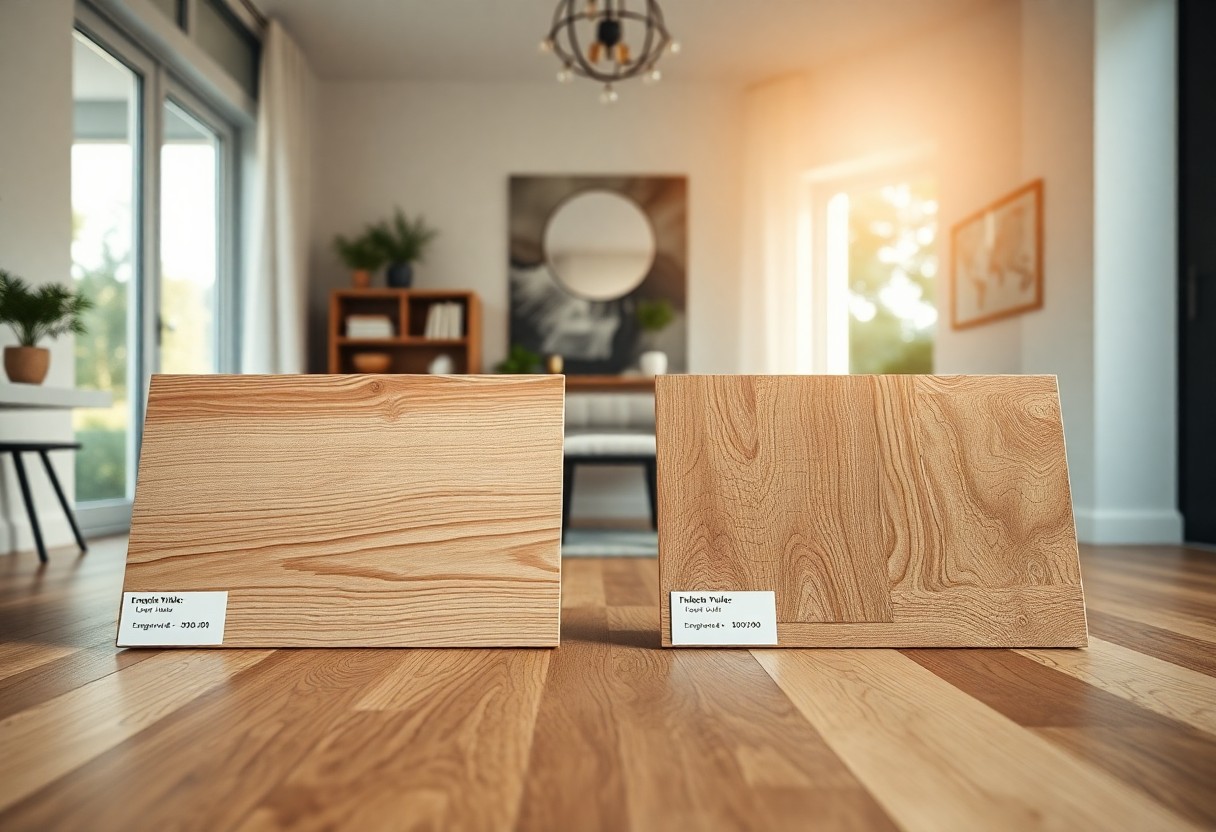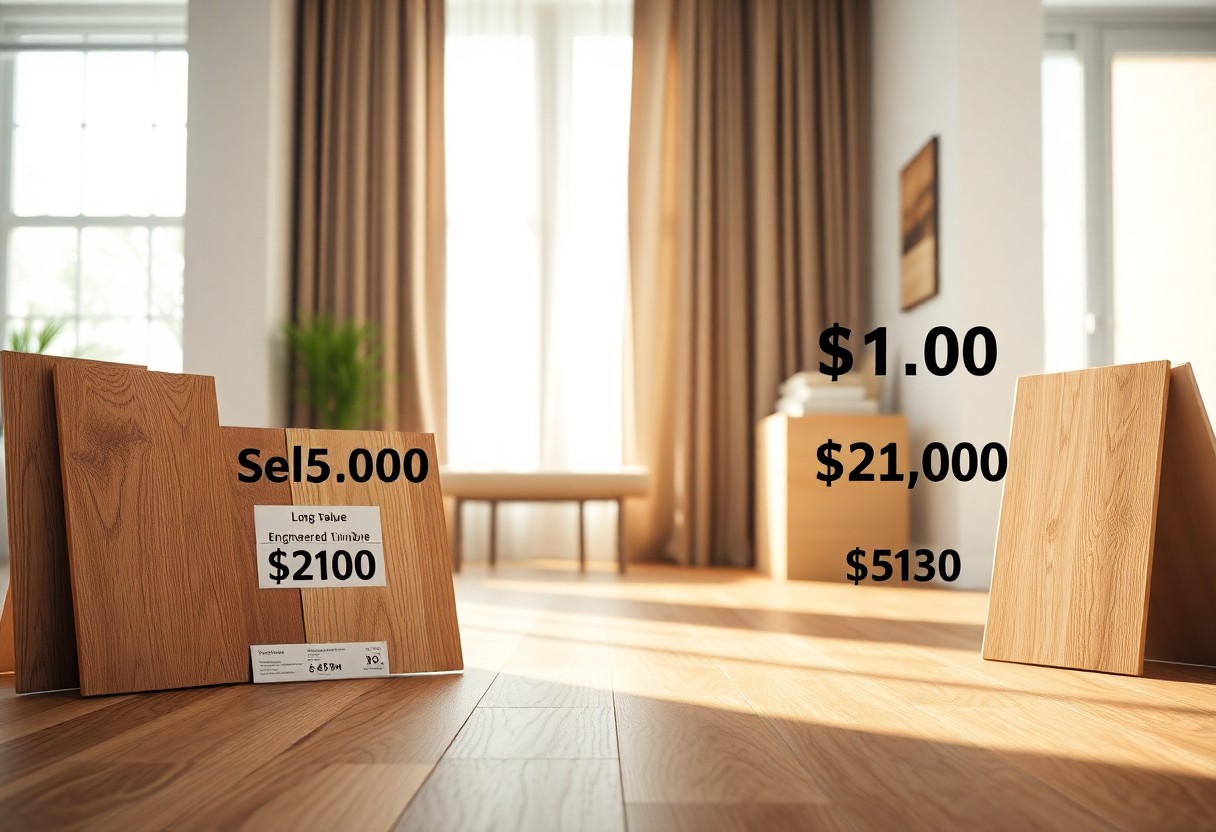With a growing interest in home aesthetics and functionality, understanding engineered timber flooring prices is crucial for you as a homeowner. This guide will provide you with key insights into the various factors influencing costs, including materials, installation, and maintenance, enabling you to make informed decisions when selecting the perfect flooring for your space.
The Price Components of Engineered Timber Flooring
Understanding the price components of engineered timber flooring is vital for informed purchasing decisions. Costs fluctuate depending on material choices, brand reputation, and installation methods. Being aware of these elements will help you budget effectively and select the best option for your home.
Material Costs and Quality Variations
Material costs for engineered timber flooring can vary significantly based on factors such as the type of wood, thickness of the veneer, and overall construction quality. High-end species like oak or walnut tend to command premium prices, while more entry-level options, such as pine or birch, are budget-friendly. Additionally, considerations like manufacturer reputation and product certifications can further influence the pricing structure.
Installation Expenses: What to Expect
Installation expenses are another critical component to assess when budgeting for engineered timber flooring. Costs typically range from $2 to $8 per square foot, influenced by the complexity of the project, the removal of existing flooring, and labor rates in your area. A larger, more intricate space may incur higher costs due to additional labor or specialized installation techniques.
Several factors will affect the final installation costs you should consider. For instance, if your subfloor requires repairs or leveling, you may face additional charges. Moreover, hiring a specialized contractor could lead to a premium rate, reflecting their expertise in a particular flooring type. It’s advisable to obtain multiple quotes and assess quality when choosing your installer, ensuring a balance between cost and craftsmanship. Investing in proper installation will enhance the longevity and appearance of your engineered timber flooring over time.
Market Trends Influencing Prices
Current market trends significantly impact engineered timber flooring prices. The rising demand for sustainable building materials has led to an increase in prices, particularly when sourcing eco-friendly options. Furthermore, technological advancements in manufacturing have influenced both costs and quality, enabling a wider range of products in the market. Stay informed about these trends to better understand fluctuations in prices and make educated choices for your flooring project.
Supply Chain Impact on Availability and Cost
The supply chain disruptions, particularly during the pandemic, have led to notable fluctuations in availability and cost for engineered timber flooring. Timber shortages, transportation delays, and rising freight costs have squeezed the market, causing prices to soar. Being aware of these supply chain challenges can help you plan your purchase timing and budget effectively.
Regional Differences in Pricing
Pricing for engineered timber flooring varies significantly across different regions due to factors like local demand, transportation costs, and regional regulations. Urban areas with a higher cost of living often see elevated prices, while rural regions may offer more competitive rates. Understanding these regional disparities will aid in your budgeting and help you identify the best options available in your area.
In metropolitan areas, engineered timber flooring can cost anywhere from $5 to $15 per square foot due to heightened demand and shipping costs. Conversely, in rural regions, the price may drop to as low as $3 to $8 per square foot, influenced by lower overhead costs and less competitive market conditions. Always consider local suppliers and their pricing strategies, as regional variations can lead to significant savings if you explore diverse options. Being informed of these differences allows you to make an empowered decision for your flooring needs.

Evaluating Long-Term Value vs. Short-Term Costs
Assessing engineered timber flooring requires balancing the lower initial costs with potential long-term financial implications. Opting for cheaper materials may save you money upfront, but can lead to higher expenses down the line through repairs, replacements, or lower property value. Considering the lifespan and performance of your flooring can provide insight into its true cost-effectiveness.
Cost-Benefit Analysis Over Time
Conducting a cost-benefit analysis entails evaluating not just the purchase price, but also factors like longevity, warranty coverage, and potential resale value. Engineered timber flooring often lasts 20+ years, sometimes offering better returns than budget options, which might require replacement sooner. Analyzing these aspects helps identify which choice aligns best with your financial goals.
Durability and Maintenance Considerations
Durability of engineered timber flooring largely depends on its construction quality, which typically features multiple layers designed to withstand daily wear. Routine maintenance, such as regular sweeping and occasional deep cleaning, is important for longevity. This flooring type often resists moisture better than solid hardwood, reducing the risk of warping or damage in humid environments.
Investing in high-quality engineered timber means considering the long-term upkeep aside from the initial cost. Many products come with wear layers that provide resistance to scratches and dents, making them suitable for high-traffic areas. Additionally, the ease of maintenance, with practices like simple sweeping and the use of mild cleaners, can save you time and money on repairs. Understanding the specifics of durability and maintenance will guide you toward a flooring solution that meets both your aesthetic and practical needs, ensuring its lasting value over time.
Expert Insights: What Professionals Recommend
Consulting with industry professionals can significantly enhance your purchasing decision. Experts often advise considering the long-term benefits of quality over immediate savings, emphasizing that investing in premium products can lead to better durability and lower maintenance costs. They also suggest examining warranties and certifications, as these reflect the product’s reliability and adherence to industry standards. Furthermore, professionals recommend visiting showrooms to see and feel the flooring before making a commitment, ensuring that it aligns with your aesthetic and functional requirements.
Choosing the Right Supplier and Installer
Select a supplier and installer who specialize in engineered timber flooring. Look for those with strong reputations, positive customer reviews, and experience in your local market. Request quotes from multiple suppliers to compare prices and services while checking for licensing and insurance. Building relationships with trustworthy professionals can provide access to valuable resources, guidance, and support throughout your flooring project.
Common Mistakes to Avoid When Purchasing
Avoiding mistakes during the purchasing process is important for a successful flooring installation. Overlooking the importance of proper measurements can lead to miscalculations and wasted materials. Many homeowners also neglect to research and compare different product brands, risking lower quality selections. Additionally, failing to account for your home’s climate and moisture levels can result in performance issues down the line.
Common missteps might include choosing a flooring option based solely on aesthetics rather than suitability for specific lifestyles, such as pets or heavy foot traffic. Ignoring available warranty terms can leave you unprotected from defects or damage, costing you more in the long run. Not considering the total cost, including installation and maintenance, can lead to budget overruns. Always evaluate different products’ durability and care requirements to ensure they align with your expectations and lifestyle needs.
Future Predictions: What the Market Holds
The engineered timber flooring market is anticipated to evolve significantly in the coming years, driven by advancements in technology and changing consumer preferences. Sustainability initiatives and a focus on eco-friendly products may lead to the rise of alternative materials and manufacturing processes, further influencing market dynamics. Homeowners should stay informed about these trends to make better purchasing decisions in the context of rising demand for environmentally responsible options.
Expected Trends in Pricing and Technology
Prices for engineered timber flooring are expected to experience fluctuations as technology improves manufacturing efficiency, potentially lowering costs. Innovations in production techniques and sustainable sourcing may create more competitive pricing and greater availability. Additionally, trends toward customization and personal preferences may lead to a wider range of price points, allowing you to find options that suit your budget while still offering quality and aesthetic appeal.
Predicting Economic Influences on Timber Flooring Costs
Economic factors play a significant role in shaping timber flooring costs, including supply chain disruptions and fluctuations in raw material prices. As timber sourcing becomes more challenging due to regulations and environmental concerns, you might see increased pricing pressures. The global economy’s performance, interest rates, and inflation can also impact disposable income, subsequently affecting your purchasing power and choices in flooring materials.
For instance, during economic downturns, lumber prices can be volatile due to decreased demand and fluctuating availability. Trade agreements and tariffs also affect costs—changes in policy can directly influence material sourcing and shipping expenses. You may need to consider these economic elements when budgeting for your flooring project, as they could lead to unexpected price increases or supply shortages, making early planning necessary for cost management. Staying abreast of market trends and economic forecasts will enable you to navigate these changes effectively.
Conclusion
Considering all points, understanding engineered timber flooring prices is necessary for making an informed purchase. You should assess the quality, brand reputation, and warranty options to ensure you get the best value for your investment. Additionally, be aware of potential installation costs and ongoing maintenance requirements that can affect your overall budget. By doing your research and comparing options, you can confidently choose the right flooring that meets your aesthetic and financial needs.





